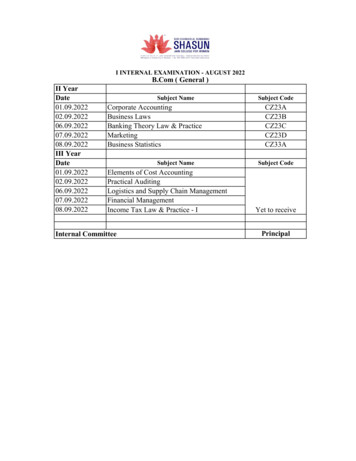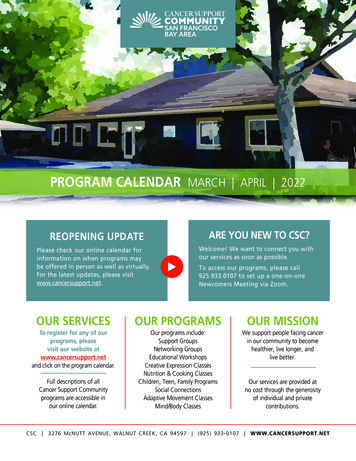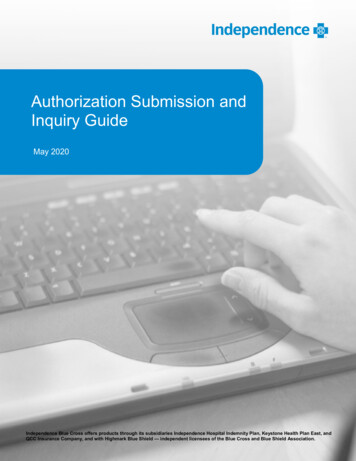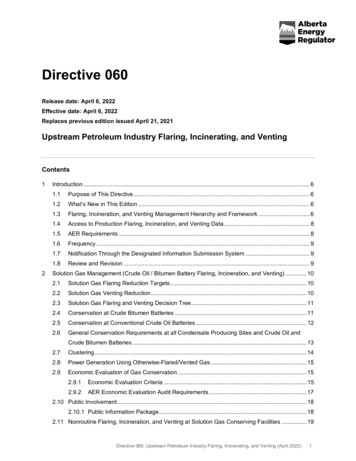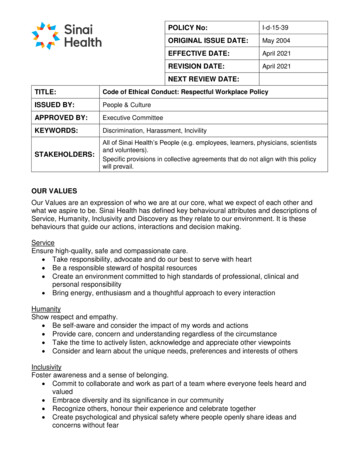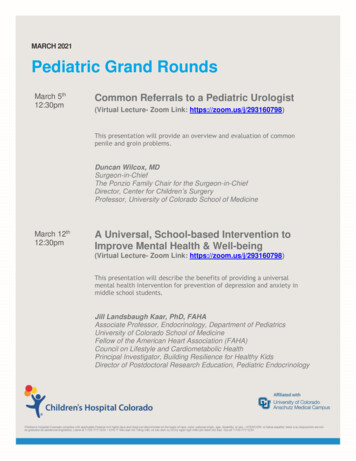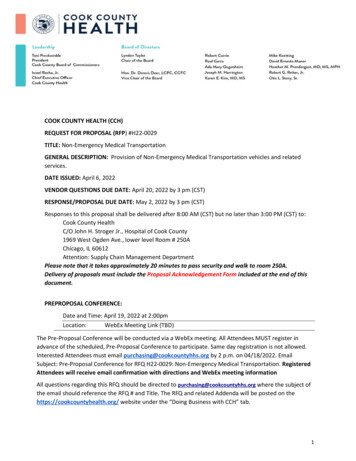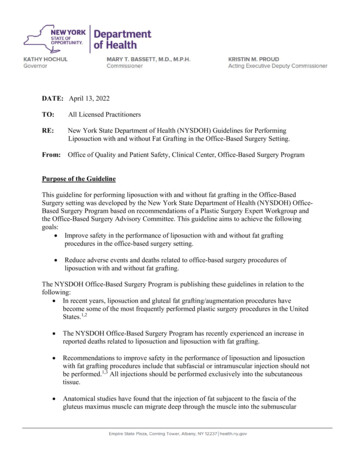
Transcription
DATE: April 13, 2022TO:All Licensed PractitionersRE:New York State Department of Health (NYSDOH) Guidelines for PerformingLiposuction with and without Fat Grafting in the Office-Based Surgery Setting.From: Office of Quality and Patient Safety, Clinical Center, Office-Based Surgery ProgramPurpose of the GuidelineThis guideline for performing liposuction with and without fat grafting in the Office-BasedSurgery setting was developed by the New York State Department of Health (NYSDOH) OfficeBased Surgery Program based on recommendations of a Plastic Surgery Expert Workgroup andthe Office-Based Surgery Advisory Committee. This guideline aims to achieve the followinggoals: Improve safety in the performance of liposuction with and without fat graftingprocedures in the office-based surgery setting. Reduce adverse events and deaths related to office-based surgery procedures ofliposuction with and without fat grafting.The NYSDOH Office-Based Surgery Program is publishing these guidelines in relation to thefollowing: In recent years, liposuction and gluteal fat grafting/augmentation procedures havebecome some of the most frequently performed plastic surgery procedures in the UnitedStates.1,2 The NYSDOH Office-Based Surgery Program has recently experienced an increase inreported deaths related to liposuction and liposuction with fat grafting. Recommendations to improve safety in the performance of liposuction and liposuctionwith fat grafting procedures include that subfascial or intramuscular injection should notbe performed.1,3 All injections should be performed exclusively into the subcutaneoustissue. Anatomical studies have found that the injection of fat subjacent to the fascia of thegluteus maximus muscle can migrate deep through the muscle into the submuscular
space, possibly causing tears in the gluteal veins, leading to fat embolisms to the heartand lungs.3These guidelines are in addition to and supplement other standards or guidelines for office-basedprocedures inclusive of liposuction with or without fat grafting.Office-Based Surgery in New York State: New York State Public Health Law (PHL) Section 230-d defines Office-Based Surgery(OBS) as any surgical or other invasive procedure accompanied by general anesthesia,deep sedation, or moderate sedation; any liposuction procedure with removal of greaterthan 500 ml; or any liposuction procedure with removal of less than 500 ml undersupplemented local, minimal or moderate sedation, or inhalational nitrous oxide in anyconcentration; where the procedure is performed by a physician, physician assistant (PA),specialist assistant (SA), or podiatrist privileged to perform ankle surgery by the StateEducation Department in a location other than an Article 28 hospital or ambulatorysurgery center. In accordance with PHL § 230-d, all physicians, PAs, SAs, and podiatrists must reportspecific adverse events occurring in relation to the performance of OBS to the Office ofQuality and Patient Safety (OQPS) of the NYSDOH. Such reportable adverse eventsshall be reported to OQPS within three business days of the occurrence of the event;suspected transmission of bloodborne pathogens must be reported within three businessdays of becoming aware of a suspected transmission. Failure to report this information falls within the definition of professional misconductidentified in Section 6530(48) of NYS Education Law.Adverse Events that must be reported according to PHL § 230-d:1. Patient death within thirty (30) days of the procedure;2. Unplanned transfer to a hospital for reasons related to the office-based surgery encounter;3. An emergency department visit within seventy-two (72) hours of office-based surgery forreasons related to the office-based surgery encounter;4. Unscheduled hospital admission or assignment to observation services within seventytwo (72) hours of the office-based surgery, for longer than twenty-four (24) hours;5. Any other serious or life-threatening events: The NYSDOH has adopted those eventsidentified and defined as Serious Reportable Events by the National Quality Forum asmeeting the definition of "other serious or life-threatening events" involving OBSpatients.In addition to the National Quality Forum Serious Reportable Events, the NYSDOH hasidentified the following events as meeting the OBS law definition of an "other serious orlife-threatening event":o Unplanned return to the Operating Room after discharge from an OBS practicefor a procedure related to the OBS procedure;
Delayed admission to the hospital for actual or potential OBS-relatedcomplications occurring between seventy-three (73) hours and thirty (30) daysafter an OBS procedure.6. Any Suspected Health Care Transmission of a Bloodborne Pathogen (BBP): a suspectedtransmission of a bloodborne pathogen (BBP) from a healthcare practitioner to a patientor between patients originating in an OBS practice as a result of improper infectioncontrol practices. BBP include but are not limited to Hepatitis B virus, Hepatitis C virus,and Human Immunodeficiency Virus.oWho Must Report Adverse Events: It is the personal responsibility of each mandated reporter to ensure that an adverse eventhas been reported. A mandated reporter includes ANY physician, PA, SA, and/or podiatrist in an OBSpractice, hospital, or other setting who believes or becomes aware of a patient complaint,complication, condition, emergency department visit, hospital admission, or death thatoccurred related to an OBS procedure.The Adverse Event Report can be found at: https://obsaer.health.ny.gov.Guidelines for Performing Liposuction with and without Fat Grafting in the Office-BasedSurgery (OBS) SettingI. Proceduralist Graduate Medical Education/Board Certificationa. Proceduralist must be a NYS-Licensed physician (MD or DO) who is certified oreligible for certification by a board recognized by the American Board ofMedical Specialties (ABMS) or American Osteopathic Association (AOA) inPlastic Surgery, Plastic Surgery within the Head and Neck, Plastic andReconstructive Surgery, or Dermatology.b. Physicians planning to perform procedures of liposuction with removal of greaterthan 500 ccs with or without fat grafting in the OBS setting must have privilegesin their specialty for the same procedure at a licensed Article 28 acute carehospital and/or ambulatory surgery center.II. Patient selection for OBS setting vs. hospitala. Patients should be under the care of a licensed practitioner (physician performingprocedure and/or patient’s primary care provider), who should evaluate thecondition of the patient, including specific comorbidities that may complicateperformance of the procedure and/or anesthetic management, and identify anddiscuss with the patient the potential risks associated with treatment options.b. A patient who, due to pre-existing medical or other conditions, is at undue riskfor complications, should be referred to an appropriate specialist for apreoperative consultation, and to another treatment setting/facility forperformance of the surgery and administration of the anesthesia as deemednecessary by the evaluation.c. Preoperative evaluation should include, but may not be limited to:
d.i. Review of patient’s medical status to include medical history, surgicalhistory, anesthetic history, social history, allergies, height, weight, currentmedications, hematological or bleeding disorders, and psychologicalstatus.ii. Review of previous medical records and interview of the patient orfamily to identify:1. Abnormalities of the major organ systems (e.g., cardiac, renal,pulmonary, neurologic, sleep apnea, metabolic, endocrine).2. Adverse experience with sedation/analgesia, as well as regionaland general anesthesia.3. History of a difficult airway.4. History of previous surgical procedures with potential of scartissue or herniations within the planned surgical site locations.5. Current medications (e.g., prescription, over the counter, herbals,supplements, or other), potential drug interactions, drug allergies,and nutraceuticals.6. Prior experience with post-operative pain, current and previoususe of pain medications, and expectation of post-operative painmanagement plan.7. History of tobacco, alcohol, or substance use or abuse.8. History of hematological disorders and/or use of medications suchas antithrombotics (anticoagulants/antiplatelet) or herbalsupplements which may increase risk of bleeding or thrombosis.iii. Performance of a physical examination of the patient to include vitalsigns, auscultation of the heart and lungs, evaluation of the airway, andevaluation of other organ systems where abnormalities have beenidentified.Document preprocedural evaluation, including the review of findings anddecision to perform procedure.III. Preprocedural testinga. Perform pertinent preprocedural testing based upon findings of the preproceduralevaluation.i. Review available laboratory test results; order additional laboratory testsguided by the patient’s medical condition, physical examination, and thepotential that results will affect the management of moderatesedation/analgesia.ii. Document review of preprocedural testing in the medical record.IV. Anticoagulation for prevention of thromboembolism (i.e., blood clots)a. Evaluate patient for history of, or potential for, venous thromboembolism andperform risk stratification as part of preprocedural evaluation.i. Utilize a venous thromboembolism risk assessment tool (e.g., ModifiedCaprini Scale).ii. Document evaluation of risk stratification and venous thromboembolismrisk assessment tool utilized in the medical record.
b. Discuss risks of hormone therapy and consider discontinuing. When hormonaltherapy is prescribed, consult with the ordering physician prior to discontinuing.c. Utilize intermittent pneumatic compression devices for mechanical prophylaxis,early mobilization, chemical prophylaxis based on venous thromboembolism riskassessment findings/score, and limit Operating Room times (recommendedOperating Room time limit of 2-3 hours).V. Maximum amount of fluid removed by liposuction in office-based setting (TotalAspirate)a. Large volume liposuction (greater than 5,000 ccs total aspirate) and/or largevolume liposuction combined with other procedures should be performed in anArticle 28 facility i.e., acute-care hospital or an Ambulatory Surgery Center.b. No more than 5,000 ccs of aspirate should be removed while performingliposuction unless the patient is monitored overnight in an appropriate Article 28facility with minimum of a registered nurse (RN) with ACLS certification inattendance.VI. Post-op care/follow-upa. Immediate postoperative care considerations:i. Identify length of required patient monitoring/recovery time in facilitypost procedure (number of hours) or if overnight monitoring needed,arrange transport and stay in an Article 28 facility.ii. Assess fluid and electrolyte requirements and plan for administration ofreplacement fluids to assure fluid and electrolyte balance.1. Fluid replacement recommendations:a. Replace preoperative fluid deficit as needed.b. Administer maintenance fluid, adjusting for changes inpatients’ clinical situation, e.g., vital signs, intake &output.c. Account for infiltration solution (super wet or tumescenttechnique).d. For patients undergoing greater than 4,000 ccs ofliposuction:i. follow all fluid replacement recommendations asabove, andii. administer 1 cc of crystalloid solution for every 4ccs of lipoaspirate greater than 4,000 ccs.b. With longer procedures, 4 to 6 hours in length, patient should not be dischargedafter less than a 1-2 hour monitored observation in a Post Anesthesia Care Unit(PACU).c. Post discharge considerations: early ambulation and chemical prophylaxis basedon patient venous thromboembolism risk assessment.VII. Maximum hours of procedures allowed in OBS setting (Length of Procedure)a. Recommended Operating Room time of 2-3 hours; not to exceed 6 hours inlength. If the Operating Room time is expected to exceed the maximum of 6
hours, the patient should be referred to an alternative facility (i.e., Article 28acute-care hospital or an Ambulatory Surgery Center) for performance of thesurgery and administration of the anesthesia.b. If the intended procedure which, under usual circumstances would not exceed themaximum 6 hours in the Operating Room, should go beyond 6 hours thefollowing processes should be in place prior to the start of the case:i. a written emergency transfer procedural plan for transferring patients to ahospital andii. a transfer agreement with a local acute-care hospital within thirty (30)minutes of the OBS facility in which the surgeon has privileges to admitpatients.VIII. No intramuscular/submuscular injection of fata. When performing gluteal fat grafting procedures, fat should be injected into thesubcutaneous space only and never cross the gluteal fascia. Intramuscular orsubmuscular fat injections are contraindicated.b. If the aesthetic goal requires a greater amount of fat than can be placed in thesubcutaneous layer, the surgeon should stage the procedure rather than injectingbelow the subcutaneous layer.References:1. Wall, S., Delvecchio, D., Teitelbaum, S., Villanueva, N. L., Dayan, E., Durand, P., Sanniec,K., & Rohrich, R. J. (2019). Subcutaneous Migration: A Dynamic Anatomical Study ofGluteal Fat Grafting. Plastic and Reconstructive Surgery, 143(5), 1343-1351. Doi:https://doi.org/10.1097/prs.00000000000055212. Teven, C. M., TerKonda, S. P., Martinez-Jorge, J., Mardini, S., & Rebecca, A. M. (2021).Liposuction and Patient Safety: Appropriately Credentialing Providers. Plastic andreconstructive surgery, 147(6), 000079703. American Society of Plastic Surgeons. (2018, January 31). Gluteal Fat Grafting Advisory.Retrieved from: isory
DATE: April 13, 2022 TO: All Licensed Practitioners RE: New York State Department of Health (NYSDOH) Guidelines for Performing Liposuction with and without Fat Grafting in the Office-Based Surgery Setting. From: Office of Quality and Patient Safety, Clinical Center, Office-Based Surgery Program Purpose of the Guideline . This guideline for performing liposuction with and without fat grafting .


